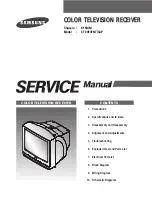
STH-DCSG
U
SER
’
S
M
ANUAL
©
2005
V
IDERE
D
ESIGN
8
3 Hardware
Overview
Figure 3-1 shows the hardware configuration of the STH-DCSG/-C.
The imager module has a milled aluminum alloy frame that rigidly holds
two megapixel imagers, separated by a fixed distance of 9 cm. Lens
mounts are an integral part of the frame, and standard C or CS-mount lenses
are screwed into these holders. There is an IR cutoff filter, with a knee at
approximately 680 nm, permanently mounted inside the lens holder. See
Section 6 for appropriate lens characteristics.
The interface module is mounted on the back of the stereo head. One IEEE
1394 port is placed at the back of the module; it is inset so that the IEEE
1394 plug does not stick out from the device.
A status LED indicates video imager activity. It will turn on when the
device is powered and connected to an IEEE 1394 card on the host
computer. The LED will begin flashing as soon as images are being
acquired by the host computer, at ½ the frame rate. Changing the video
modes (frame size, decimation) will cause the frame rate to change, and this
will be reflected in the LED flash rate.
There are no user-settable switches on the STH-DCSG/-C.
3.1 Hardware
Schematic
Figure 3-2 shows the design of the internal hardware of the STH-DCSG/-C.
In the stereo imager module, two CMOS imagers, each of size 640x480
pixels, digitize incoming light into a digital stream. The imagers operate in
progressive mode only, that is, each line is output in succession from the
full frame.
The maximum video rate is 12 megapixels per second from each imager.
The imagers are synchronized to a common clock, so that the corresponding
pixels from each imager are output at precisely the same time. Special
interlace electronics convert the individual streams into a single pixel-
interlaced stream at 24 MHz. The interlaced stream contains one byte from
the left imager, then the corresponding byte from the right imager, then the
next byte from the right imager, and so on.
The interlaced video stream is transferred to the IEEE 1394 interface
module, which communicates to the host PC over an IEEE 1394 digital
cable. The module also accepts commands from the host PC over the cable,
and uses these commands to control imaging modes such as exposure or
subwindowing.
The IEEE 1394 interface module can communicate at the maximum IEEE
1394 data rate, 400 MBps.
3.2 Frame Formats and Rates
The IEEE 1394 interface electronics on the STH-DCSG supports a
maximum rate of 32 megapixels per second. At this rate, there is no need
for large buffer memories to hold video data on the stereo device. The
STH-DCSG/-C conforms to the IIDC version 1.30 camera specification.
Frame rates and frame sizes are set by this standard. The STH-DCSG/-C
implements the formats shown in Table 1.
The Digital Camera Specification was set up with monocular cameras in
mind. To conform to this specification, the STH-MDS/-C uses the YUV
Figure 3-1. Physical layout of the STH-DCSG/-C stereo head.
Left
C/CS-
mount lens
IEEE 1394
port on back
Right
C/CS-mount
lens
LED
indicator









































